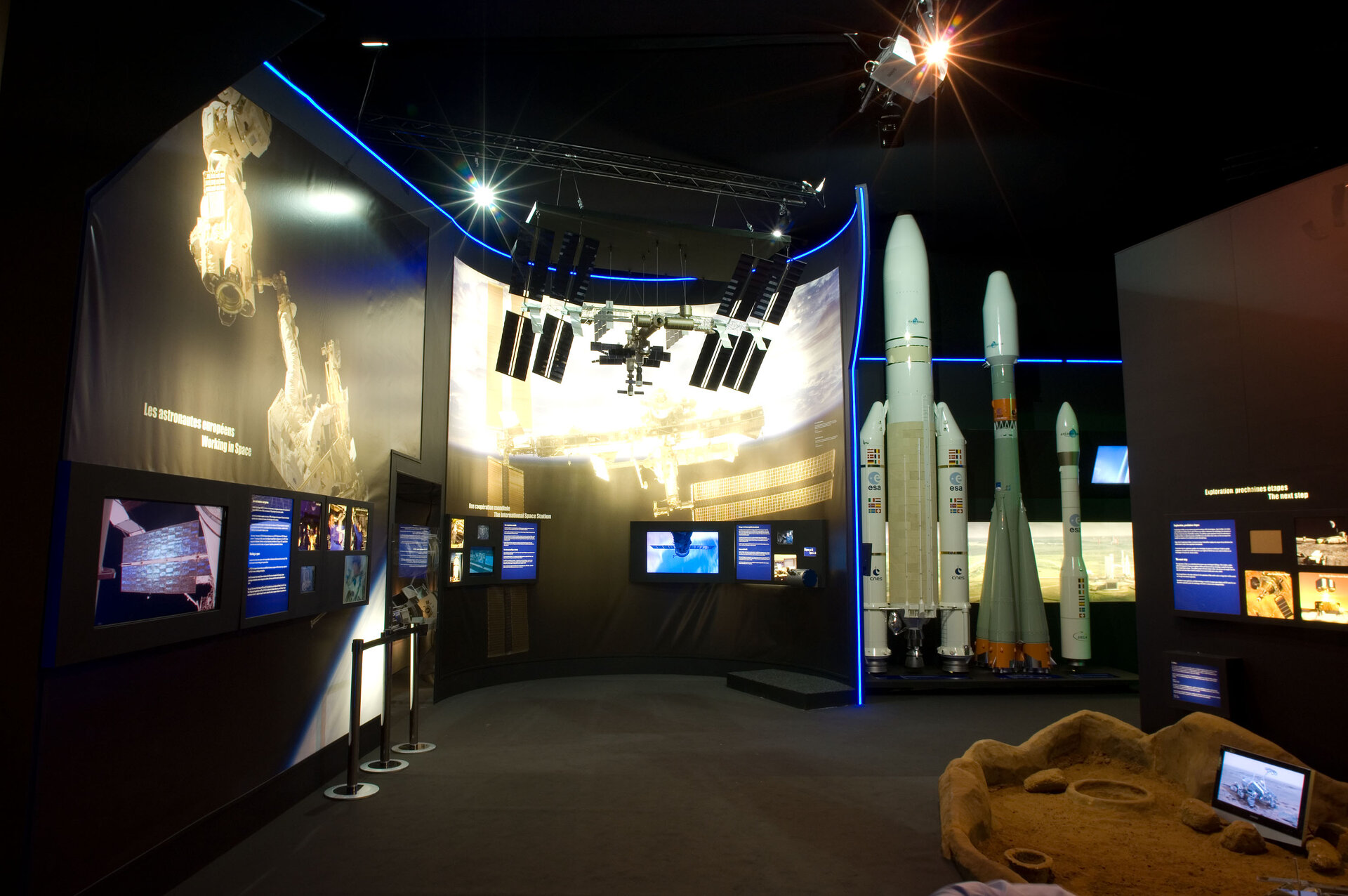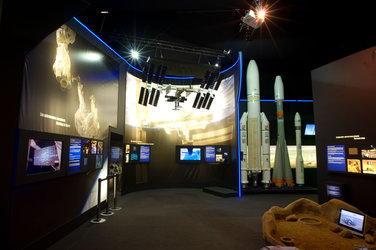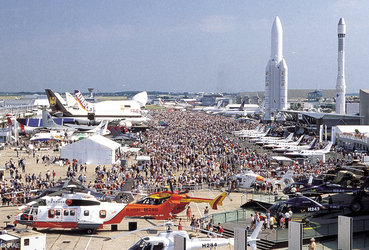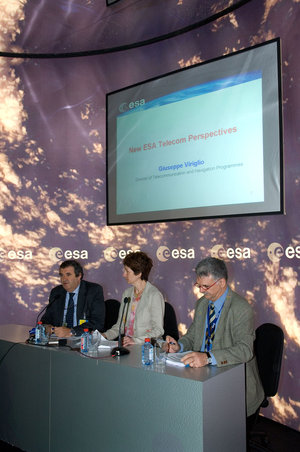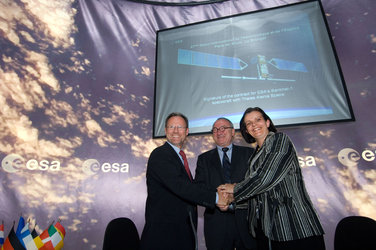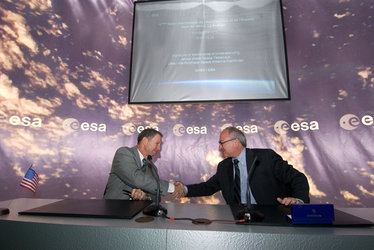ESA pavilion 'L’Europe de l’Espace, Europe in Space' at the 47th Paris Air Show
This year the International Paris Air Show will take place from 18 to 24 June at Le Bourget. The ESA Pavilion will be located in its usual place between the full scale models of the Ariane 1 and Ariane 5 launchers, next to the permanent Air and Space Museum at Le Bourget.
The theme of the pavilion, 'L’Europe de l’Espace, Europe in Space , will communicate the importance of space as a key factor of discovery, competitiveness and European identity to politicians, decisions-makers, the international aerospace community, media and the general public in order to raise public awareness and promote ongoing and future space programmes.
Why the title 'L’Europe de l’Espace; Europe in Space'? “In 2007, explains Fernando Doblas, Head of the ESA Communication Department, “we are celebrating the 50th anniversary of both, the start of the space age and the start of the construction of Europe. What better year could we have chosen to send the message to our fellow citizens of the key importance of space for Europe in a world in quick evolution? Space is set to be a vital part of Europe’s strategy, as a driver for scientific and technological progress, as an economic growth catalyst and as a key element for sovereignty. Thanks to 40 years of European cooperation in space, 40 years of successes, we can say that we have contributed significantly to Europe’s presence in the world and to Europe’s economy. We are committed to communicating it to our fellow citizens.”

The ESA exhibition, conceived as a journey “from Earth… to Earth”, starts with a tiny Earth in a dark environment. Understanding space is essential to understand the Earth; to use space is to improve life on Earth; and to dream of space is to build the future.
The visit continues with a stunning image of the origins of the Universe, introducing Cosmic Vision, ESA’s ambitious programme for future scientific missions at the cutting-edge of technology. Within the fascinating world of astronomy, current and ongoing missions are presented, from the pioneering space telescopes beyond the visible of the 1970’s and ‘80s to Herschel and Planck, planned for launch in 2008. Images of the Milky Way, stars and other celestial objects allow us to learn more about our origins and our place in the Universe.
Next step in the journey is a full immersion in the Solar System with huge images of the Sun and the first European views of Venus, Mars, the Moon, and Titan. By studying planets and moons and by comparing the different processes that shaped our Solar System, planetary missions give scientists a better understanding of our fragile and precious Earth.
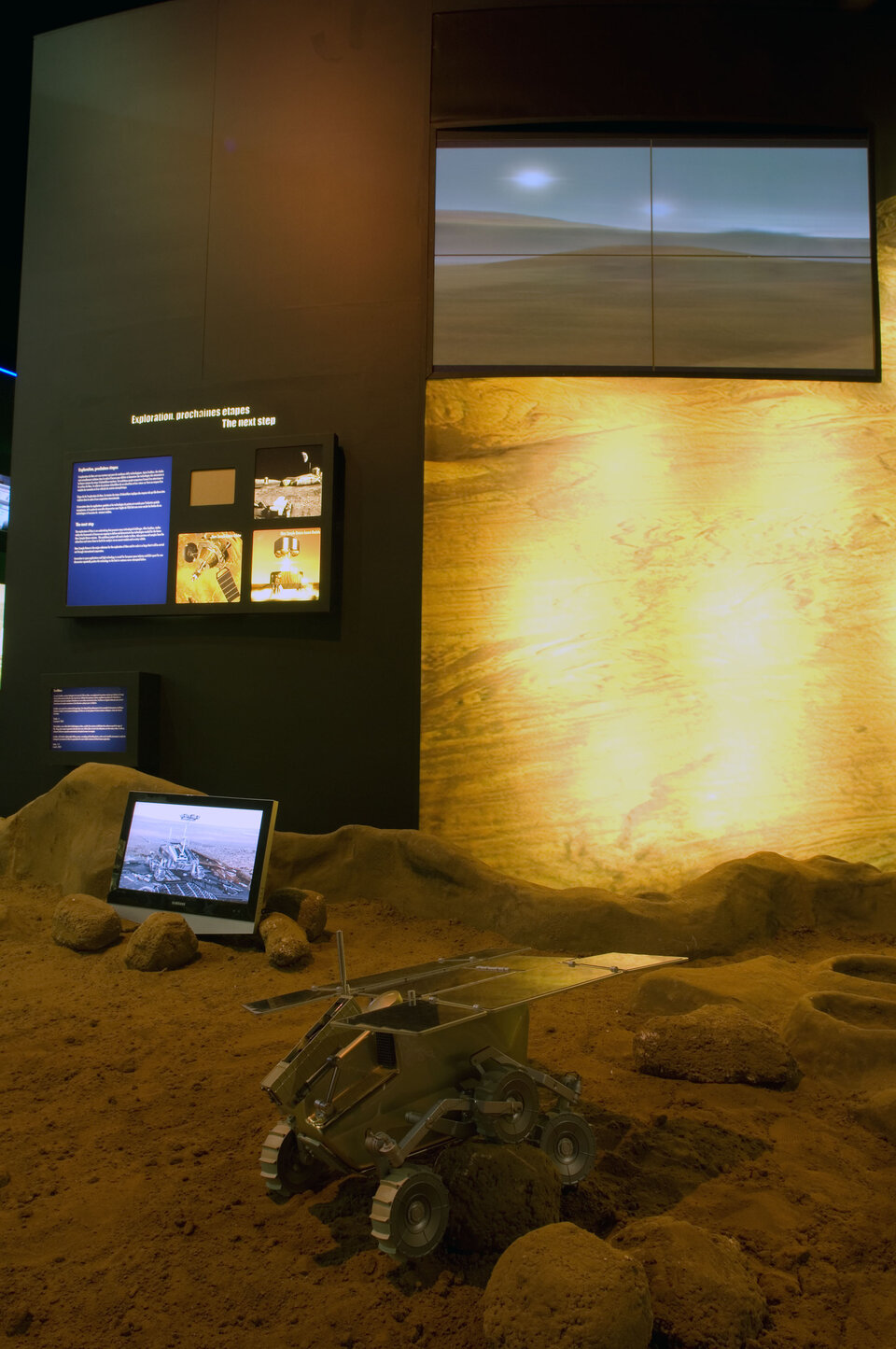
An impressive film of Mars Express images allows visitors to travel through the canyons of Mars and, taking the road to the future, to discover ExoMars, the first ESA mission scheduled to land on the red planet in 2013.
Thanks to their innovative technology, the Aramies and Scorpion robots walk and climb and are capable of operating autonomously in extremely difficult environments such as the steep slopes of the canyons and craters of the Moon and Mars, crucial for future planetary exploration.

Journeying back towards Earth, visitors see exciting 3D images of the International Space Station, and a scale model of its final configuration. Special highlights in this area will be the Automated Transfer Vehicle (ATV), and the scientific laboratory Columbus, the two major European contributions to the ISS, the greatest international scientific project of all time. In the same area, astronaut activities emphasise the importance to carry out experiments and scientific research in microgravity conditions to understand the fundamental laws of nature.
The European launchers Ariane 5 and Vega and the Russian-built Soyuz planned for launch from Europe’s Spaceport in French Guiana are exhibited together with a new and impressive high-definition multi-screen experience “The family of European launchers”. It underlines the strategic importance of guaranteeing Europe’s independent access to space and in developing a commercial space market.
Reaching the Earth, visitors see how Earth observation satellites have given Europe a leading role in understanding the weather and environmental change. Since 1977, the Meteosat series has provided a wealth of data for the meteorological community, while over the last 15 years Envisat and the ERS remote sensing satellites have allowed scientists to build data sets on environmental phenomena.

Data from space are vital for studying the land, sea and the atmosphere, for monitoring critical phenomena such as earthquakes, flooding and other natural disasters and keeping a watchful eye on human impact on the environment.
The discovery of the exhibition continues with telecommunication satellites and the European satellite navigation system, Galileo, which will provide a highly accurate, guaranteed global positioning service under civilian control.
Bringing together vision and innovation in space, visitors will be immersed in the technology area with models of the Proba-2 and Proba-3 low-cost, in-orbit demonstration satellites, which will validate new spacecraft technologies while carrying scientific instruments.
A dedicated education area shows how ESA activities aim to inspire the younger generation to pursue careers in science and engineering, thus ensuring the continuation of a long-standing tradition of European excellence in science and technology.
Updated programme
| Monday 18 June | |
| 14:15-14:45 | Signature of the contract for ESA's Sentinel-1 spacecraft with Thales Alenia Space. |
| 15:00-15:30 | Signature of ESA/NASA memorandum of Understanding for the James Webb Space Telescope and LISA Pathfinder. |
| 16:30-17:30 | "The European Space Policy is now a reality: where do we go from here?": press conference with ESA Director General Jean-Jacques Dordain. |
| Tuesday 19 June | |
| 10:00-11:00 | "Mars 500" press briefing /status report on the project and call for candidates to take part to a 500 day simulated mission to Mars. |
| 11:30-12:30 | "SMEs for space under the spotlight": overview on the the SineQuaNet project , an expert network providing technical and engineering support to SMEs (more at: http://www.esa.int/ SPECIALS/SME/SEM9U3BUQPE_0.html) and launch of a novel organisation of SMEs marked by the signature of Memorandum of Understanding between ESA and the new organisation. |
| 15:30-17:00 | "The global exploration strategy: a framework for coordination": presentation of a document on the international rationale and long-term strategy for space exploration, and round table discussions with European political stakeholders. |
| Wednesday 20 June | |
| 10:00-11:00 | "Status of the Telecommunications Programme and the Alphasat project": press briefing with Giuseppe Viriglio, Director of Telecommunications and Navigation Programmes at ESA and Magali Vaissière, ESA's Head of Telecommunications Department. |
| Thursday 21 June | |
| 15:30-18:00 | "Vega launcher Industry day": ESA management and Industry representatives meet to take stock of the programme status and review milestones to come. |
| Friday 22 June | |
| 10:00-11:30 | Presentation of ESA's Education activities with special emphasis on YES 2 (a student-built satellite to be launched in mid-September this year) and award ceremony for the "Students aerospace contest": some 50 university students in 11 teams all around Europe worked on the design of a suborbital plane for one year. Initiative promoted by the Astronaut Club Européen (ACE) and sponsored by Dassault, Thales, Safran, GIFAS and the IAF. |
| Saturday 23 June (public day) | |
| 10:00-12:30 and 14:30-16:00 | ESA Astronauts on Stage, a Space Quiz and 3-D demonstrations will fill the day with excitement, discovery and dream, targeting the general public and young visitors in particular. (ESA astronauts will be available to media for interviews upon request). |
| Sunday 24 June (public day) | |
| 10:30-12:30 and 14:30-16:00 | Space Quiz and 3-D demonstrations will fill the day with excitement, discovery and dream, targeting the general public and young visitors in particular. |


